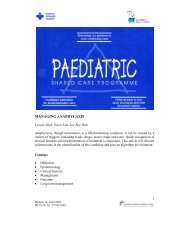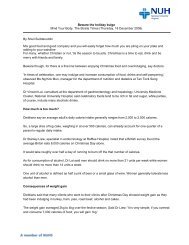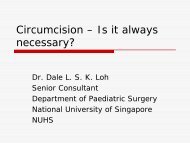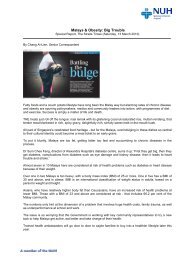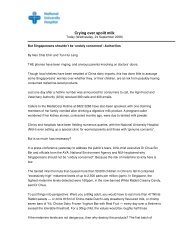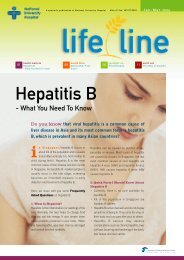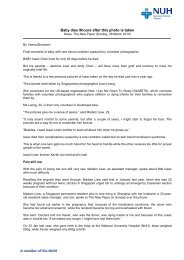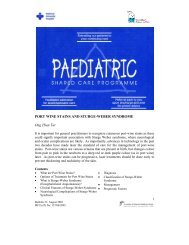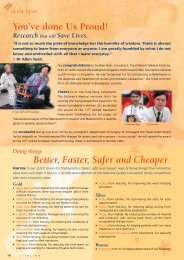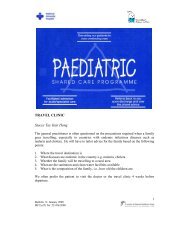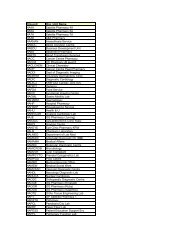She got her heart reshaped - National University Hospital
She got her heart reshaped - National University Hospital
She got her heart reshaped - National University Hospital
You also want an ePaper? Increase the reach of your titles
YUMPU automatically turns print PDFs into web optimized ePapers that Google loves.
<strong>She</strong> <strong>got</strong> <strong>her</strong> <strong>heart</strong> <strong>reshaped</strong><br />
Mind Your Body, The Straits Times (Thursday, 11 June 2009)<br />
Housewife Surayah Idris took a leap of faith and tried a new method of remodelling <strong>her</strong> failing <strong>heart</strong>. POON<br />
CHIAN HUI finds out about the Ferrazzi procedure.<br />
"I felt as if I had died and woken up again."<br />
Madam Surayah Idris (left), on <strong>her</strong> recent ordeal<br />
-- PHOTOS: JOSEPH NAIR FOR THE STRAITS TIMES<br />
The Ferrazzi procedure does not make use of<br />
foreign material, making it safer, said Professor<br />
Theodoros Kofidis (above).<br />
When multiple <strong>heart</strong> attacks in January left housewife Surayah Idris, 50, dangerously ill, doctors <strong>her</strong>e had to<br />
make a quick decision.<br />
Should they take a chance, after weighing the pros and cons, and perform a new procedure that has<br />
emerged only a few weeks ago?<br />
The new method of reshaping abnormal <strong>heart</strong> structure caused by <strong>heart</strong> failure, called the Ferrazzi<br />
procedure, was devised by Italian surgeon Paolo Ferrazzi and published earlier in January.<br />
'Her <strong>heart</strong> was functioning at only 15 per cent by then,' said Assistant Professor Theodoros Kofidis, a<br />
cardiothoracic surgeon at the <strong>National</strong> <strong>University</strong> Heart Centre. 'If nothing was done, the next <strong>heart</strong> attack<br />
might kill <strong>her</strong>.'<br />
This is because some of the muscles in the wall of <strong>her</strong> left <strong>heart</strong> chamber had died and had thinned,<br />
resulting in a condition called eccentric ballooning, he said.<br />
Known also as an aneurysm, it refers to the balloon-like bulge that forms when the wall of dead <strong>heart</strong><br />
muscles thins like wallpaper.<br />
When the <strong>heart</strong> becomes out of shape, it ceases to function normally and may not be able to pump blood<br />
efficiently, said Prof Kofidis. 'This condition can cause shortness of breath and the person may not be able to<br />
perform everyday tasks well,' he said.<br />
Unfortunately, it was not the only problem that Prof Kofidis had to fix. Scans revealed that Madam Surayah,<br />
who was hospitalised at the <strong>National</strong> <strong>University</strong> <strong>Hospital</strong>, had a hole in <strong>her</strong> <strong>heart</strong> - one of the most feared<br />
complications from a <strong>heart</strong> attack - as well as blocked coronary arteries.
Both problems can be fixed with relatively good results if they occur on their own. However, the success rate<br />
becomes more uncertain for a combined operation coupled with the Ferrazzi procedure.<br />
'Because of the multiple complications, t<strong>her</strong>e was a significant chance she would not make it,' said Prof<br />
Kofidis.<br />
Told about these odds, Madam Surayah, who is fearful of invasive surgery, nevertheless chose to go ahead<br />
with <strong>her</strong> family's support.<br />
Her husband, Mr Masban Masood, 50, a teac<strong>her</strong>, said: 'I told my children before the operation to be<br />
prepared for the worst.' The couple have two children, a 26-year-old daughter, who is a marketing executive,<br />
and an 18-year-old son, who is in national service.<br />
In the landmark three-hour surgery on Feb 16, Prof Kofidis performed open-<strong>heart</strong> surgery to close the hole<br />
and three bypasses to clear the blocked arteries on top of the new reshaping procedure.<br />
The Ferazzi procedure differs from its predecessor, the Dor procedure, which requires the insertion of a<br />
plastic patch to fix the aneurysm.<br />
The Ferrazzi procedure does not make use of foreign material which makes it much safer, said Prof Kofidis.<br />
Blood loss and risk of infection are also reduced. In addition, the <strong>heart</strong> is returned to its natural oval shape -<br />
unlike the Dor procedure which results in a sp<strong>her</strong>ical <strong>heart</strong>.<br />
Hence, the <strong>heart</strong> will be able to beat much better, he added.<br />
'I see the Ferrazzi as an evolution of the Dor procedure that gives better recovery,' he said. 'It is, at present,<br />
the most natural reshaping technique for patients with an eccentric <strong>heart</strong> aneurysm.'<br />
Prof Kofidis hopes that Madam Surayah's landmark operation <strong>her</strong>e will inspire more <strong>heart</strong> failure patients to<br />
consider the Ferrazzi procedure so that they can recover better. He estimates that t<strong>her</strong>e are at least 100<br />
people in Singapore who can benefit from it annually.<br />
As for Madam Surayah, the effects were seen almost immediately. Two days after the operation, she was<br />
able to walk without support and a week later, she was discharged from hospital.<br />
'It was a very scary experience because I never knew that I had a <strong>heart</strong> problem,' she said, adding that she<br />
treasures <strong>her</strong> family ties more than ever. 'I felt as if I had died and woken up again.'





